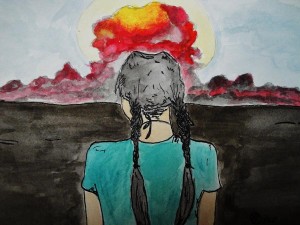August 6th -1945 – Nagasaki and Hiroshima Bombings by 6H
The Hiroshima Bombings
Dangerous and devastating
People having trouble
Communicating.
Full of fright
Unable to fight
Shocking and painful surroundings
Concrete hits the ground pounding
It was 1945
When the radiation filled the sky
The land is flat
From the explosive attack
If you look ahead
There are people dead
People die in unfortunate ways
They will love each other always.
Sickening wounds that never heal
Broken hearts that continue to feel.
By Blake
6H have been viewing images from Nagasaki Journey (some are confronting and not for younger years). They discussed the impact of images on the viewer, considering features such as portrayal of people and places, colour, light and shadow, balance and unity, contrast, mood, perspective, symbolism, salience of various components, etc. They also spoke about the impact of the text slides and their effect on the viewer. Then they discussed how similar ideas could be communicated through words alone, and techniques that could be used to emphasise key ideas, eg repetition, simile and metaphor, alliteration, imagery, personification, etc. Finally, the students created a poem which communicates what the photos make them think and feel, and to encourage people to live in peace. Some of their poems have been published on their individual blogs. Others are still in draft form and will be published shortly. Click on the names to read them.








